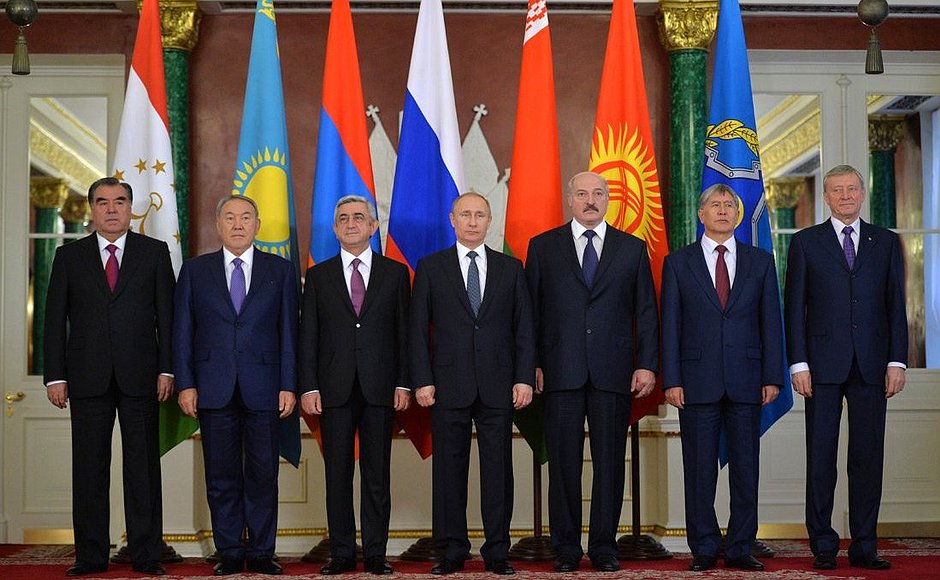 Image Credit: http://en.kremlin.ru/events/president/news/47281
Image Credit: http://en.kremlin.ru/events/president/news/47281
CSTO: A Military Pact to Defend Russian Influence
Following the failure to appoint a new Secretary-General at the latest December meeting of Russia-led security pact, the Collective Security Treaty Organization (CSTO), member countries agreed to pick the next Secretary-General in April. The inability to agree on this new Secretary-General is unsurprising given the competing interests of the CSTO member countries: Russia, Kazakhstan, Armenia, Belarus, Kyrgyzstan and Tajikistan. Based on defense spending data from SIPRI, Russia contributes 95% of the military spending and remains its de facto leader. Originally pitched as the “Eastern NATO,” the CSTO has failed to become a significant factor for the security of its member states. That does not mean that the CSTO does not have its uses.
Participation in CSTO exercises increases the interoperability of participating forces, and the CSTO can play a role in facilitating broader security cooperation between its member states, though this cooperation does have its limits. There has not yet arisen a situation in which CSTO forces have ever been deployed in spite of multiple instances of member countries requesting their use. These instances include Kyrgyzstan’s 2010 Osh riots, Tajikistan’s struggles against rebel forces, and limited bouts of combat between Armenia and Azerbaijan in the disputed Nagorno-Karabakh region.
The CSTO’s primary value comes from its political aspects. Specifically, the laws and regulations of the agreement hinder future American attempts at building influence in the region and tackling regional issues of US interest. Potential US attempts at basing military resources in a CSTO member state, using Manas Air Base again for instance, would be more difficult due to Article 7 of the CSTO Charter. This provision grants Russia veto power against any such efforts. Russia also remains the de facto primary arms dealer for all CSTO member states and allows CSTO member states to purchase arms at the same price as the Russian government. This rule raises the competitiveness of Russian arms exports to these countries.
The CSTO most closely resembles a project to spread and deepen Russian influence, continue building upon preexisting dependencies on Russia, and prevent the entrance of other powers. This deepening can be seen through common membership in further Russia-dominated groups with similar effects such as the Eurasian Economic Union whose members are also Russia, Belarus, Kazakhstan, Armenia, and Kyrgyzstan. Effectively, CSTO membership limits the range of actions a foreign government may pursue with the host government without Russian authorization. This does not mean that American attempts at fostering cooperation within the region are pointless, but that the cost and complexity of such efforts are higher than they would otherwise be.
The CSTO’s ability to fulfill Russian political and economic objectives has clear limits. Despite being able to purchase arms at a major markdown, Kazakhstan continues to pursue a number of arms deals with other powers while building up its own arms industry. Russian influence within Central Asian CSTO members is also being increasingly challenged by the growth of Chinese influence through its “One Belt, One Road” infrastructure initiative. In the case of Kazakhstan, it will likely continue its multi-vector foreign policy despite its membership in the CSTO.
In terms of US interests, citizens of Kazakhstan and Kyrgyzstan are still being actively targeted by ISIS recruitment efforts that, according to the Kazakh and Kyrgyz governments, have inspired roughly 400 Kazakhs and more than 500 Kyrgyz citizens to join ISIS. Working alongside these governments to enhance counterterrorism efforts and prevent potential ISIS recruits from leaving the country is worth pursuing, but those efforts may be hampered if they lack Russian consent. This dynamic played out in 2014 when the Manas Air Base, a logistics hub for US forces in Afghanistan, was closed by the pro-Russian Atambayev government in Kyrgyzstan. Both Tajikistan and Kyrgyzstan are important routes for Afghan opiates, but have failed to effectively stop drug smuggling. It may be possible for the US to work with the CSTO or alongside Russia to foster better cooperation between the two states and to strengthen their borders and counternarcotic capabilities.
Ultimately, the US must be aware that efforts to address US security interests in CSTO member states without Russian involvement will be constrained, and any efforts to build influence in these states will be an uphill battle. Without a US-Russia rapprochement or significant shift in the states’ domestic politics, this is unlikely to change in the near future.






